Erin Springs
This material is
donated by people who want to communicate with and help others. Every effort is made to
give credit and protect all copyrights. Presentation here does not extend any permissions
to the public. This material can not be included in any compilation, publication,
collection, or other reproduction for profit without permission. |
Just south of Lindsay across the Washita River, this small town was originally called
Elm Springs and was a stage stopping point. A large elm tree grew behind the stage
depot and a natural spring ran between the depot and the river which gave it the name, Elm
Springs. (In "Oklahoma Place Names" by George H. Shirk, states it was
originally named Edgewood.
The first home in Erin Springs was built in 1871 by Frank Murray, an Irish immigrant
from Londonderry. Murray eventually became a large land owner and rancher. He
had 20,000 acres of land and 26,000 head of cattle. In 1879-1880 Murray began
construction of a large stone house which is still standing and preserved by the Oklahoma
Historical Society.
Elm Springs was changed to Erin Springs in honor of Frank Murray's sister Erin
Westland. (In "Oklahoma Place Names" Shirk states that it was named for Erin
Murphy, son of a local rancher.)
In 1889 when the land run opened the territory, the large land acreages began to
disappear and small communities were formed. Erin Springs was later noted for it's
oilfield and businesses rather than for its farming industry as it was in Murray's day.
This small community is now a place where people pass to get to Lindsay.
The Lindsay Historical Society's
MURRAY-LINDSAY MANSION
at Erin Springs Oklahoma.
During the 1870's and 1880's enterprising mixed-blood Indians
and intermarried whites carved extensive ranches from Indian
lands in the Chickasaw Nation. Two of these pioneers
- Frank and Alzira Murray - constructed a massive Mansion
in the center of their empire. The Lindsay Historical Society is operating this
mansion as a physical legacy of those enterprising
men and women. |
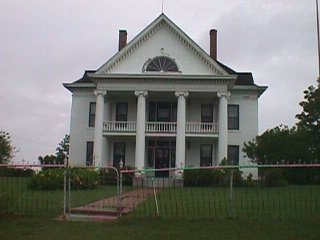 |
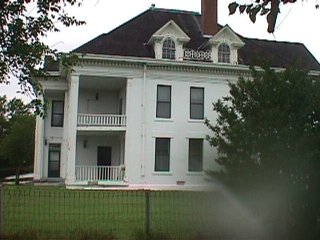 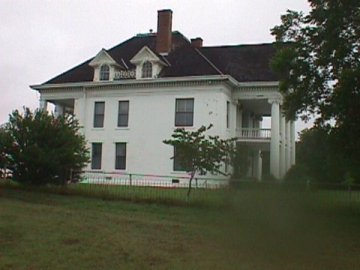 |
The House
With unlimited access to rich tribal lands and growing markets for beef
and produce in the territory, the Murrays prospered. To house their eight children
and to reflect their new status, they began work on a large stone house. The
principal building material was obtained from a nearby quarry, and the mason was John
Coyle, a Scotsman. Lumber was hauled from Gainesville, Texas, and walls and
partitions in the downstairs level were eighteen inches thick and solid rock. The
original building was a two-story square design, with full basement and attic. A
wooden veranda extended across the front facade. When finished, it was the largest
and most ornate house in the western Chickasaw Nation, containing 15 rooms, 2 baths
and 4 fireplaces. |
House Remodeled
In 1902 Alzira remodeled the old stone house. She
removed the front veranda and installed a classic
portico with Grecian columns. She also stuccoed the
brick walls and raised the roof for more sleeping
rooms in the attic. The house which emerged from
this facelift is the Murray-Lindsay Mansion operated
by the Lindsay Historical Society. Representing the
role of mixed-bloods and intermarried whites in the
economic development of the Indian Nations, their
house is open for all to see. 2 miles south of 1/2
just up the road from Erin Springs cemetery.
Open 1:00p.m. to 5:00p.m. except for Mondays.
|
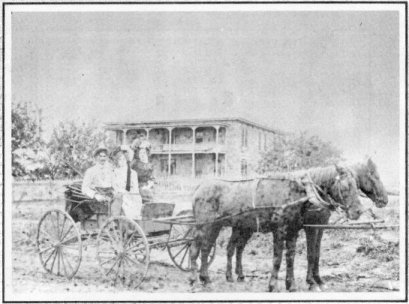
The original rock house, started by Frank Murray in 1879.
Seated in the buggy are John McCaughey, Erin and Lula Murray.
|
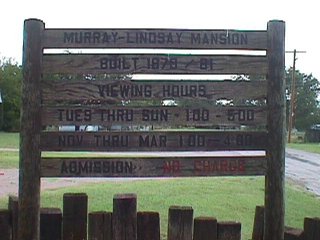
Business in Indian Territory
Frank and Alzira administered their far-flung operations from their home for the
next then years, but their prosperity waned as the business sank into debt. In 1892,
mired in financial collapse, Frank Murray died, leaving his Indian wife to salvage their
fortunes. Alzira proved she was ready for the challenge. She reorganized the
farm and pared expenses, but just as her economic fortunes were rebounding, unlimited
access to Indian land was halted by allotment and tribal dissolution. Despite this
setback, she made a transition into non-farm business. She was an organizing officer
and major stockholder in the First National Bank of Lindsay, a stockholder in banks in
Chickasha and Purcell, and a part-owner of a mill and grain elevator in Pauls Valley.
From land and cattle to stocks and bonds, Alzira Murray proved that Indians could
adapt to new conditions. |
The Murrays
In the 1850's, young Frank Murray arrived in
New Orleans. Although from a prominent family
in Ireland, he entered the new land penniless.
He drifted for awhile, and finally arrived in Indian
Territory. While on that frontier he met and married Alzira
McCaughey. Alzira was a Choctaw who had been
16 years old when she joined her tribe in Indian
Territory. In 1868 she married Captain William
Powell. They had a daughter, Anita, born in 1869.
Captain Powell died two months later. IN 1871,
Alzira met and married the ambitious Frank Murray.
In 1888, Anita married Lewis Lindsay. The young
couple and Anita moved to Pauls Valley on the
western edge of the Chickasaw Nation, and from
there they relocated in Erin Springs, about two miles
south of Lindsay. Situated near the Washita River,
their four-room cabin was also on the stage line between
Caddo and Fort Sill, a busy road which carried
freight and passengers from the rail station to the fort.
Their nearest neighbors were reportedly 25 miles distant.
|
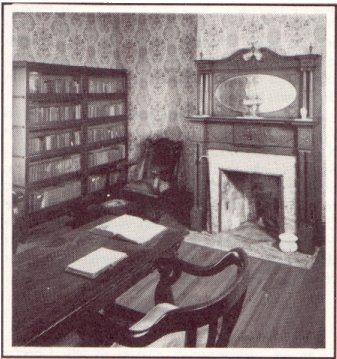 The library is one of 15 rooms in the lovely old mansion
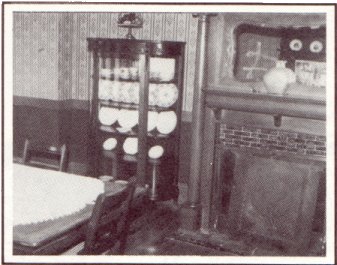
This Dining Room is typical of the excellent craftsmanship that
was used in construction of the old mansion. |
The Land
As an intermarried citizen of the Choctaw tribe,
Murray could legally improve and exploit Indian land.
He used this advantage to build a vast ranch and farm.
Beginning with a small tract of land, he and
Alzira eventually controlled more than 20,000 acres
of land, and ran more than 26,000 head of cattle
It also was reported that in one year they raised
400,000 bushels of corn. One cornfield included
8,000 acres and stretched three miles wide and
five miles long.
Business in Indian Territory
Frank and Alzira administered their far-flung operations
from their home for the next then years, but their
prosperity waned as the business sank into debt.
In 1892, mired in financial collapse, Frank
Murray died, leaving his Indian wife to salvage their
fortunes. Alzira proved she was ready for the
challenge. She reorganized the farm and pared
expenses, but just as her economic fortunes
were rebounding, unlimited access to Indian land
was halted by allotment and tribal dissolution.
Despite this setback, she made a transition
into non-farm business. She was an organizing
officer and major stockholder in the First
National Bank of Lindsay, a stockholder in banks
in Chickasha and Purcell, and a part-owner of
a mill and grain elevator in Pauls Valley.
From land and cattle to stocks and bonds, Alzira
Murray proved that Indians could adapt to new conditions.
|
Frank & Alzira McCaughey Murray
One of Indian Territory's truly liberated businesswomen and mothers, Alzira
McCaughey Murray was born Feb 8, 1848, at Starksville, Oktibbeha Co ., Mississippi and
claimed Choctaw citizenship through her great grandmother, Molly (Ar-chi-ho-yo) Folsom.
After the 1863 death of her father, John McCaughey during the siege of Vicksburg,
the widow and family moved to Oklahoma here she had lived with her family as a young girl
when the Folsom/Dibrell family had moved after the Choctaw removal.
Married first to William Powell, Capt. USA, at Fort Arbuckle and second to Frank Murray
on April 30, 1871 at Fort Gibson, Alzira settle quickly into post Civil War era Indian
Territory life. The newlyweds and her small daughter, Anita, moved first to Pauls
Valley for a few months before finally settling in the Erin Springs area where they were
the original settlers, based on her Indian heritage allotment.
Alzira's mother and family also moved to the area where the family prospered
in farming and ranching. Older children of the family were sent
to Catholic schools in Denison, Texas and Sacred Heart Academy near present Shawnee,
Oklahoma.
In 1879, Frank started to build the old rock mansion which still sands, remodeled, at
Erin Springs today - an Oklahoma Historical Society attraction. When completed in
1883, it was the largest and most ornate house in the western Chickasaw Nation.
Houseguests ranged from territorial governors to Indian chiefs. Since it was near
the Ft. Sill road, many officers from the post also visited there.
Over the next ten years, their prosperity waned, until when Frank died in 1892, he left
his wife in debt and with a large family. She reorganized the farm and ranch and
pared expenses, but when unlimited access to Indian land was halted, she switched to
non-farm business. A stockholder in the Chickasaw National Bank of Purcell, First
National Bank of Chickasha, with interests in the Purcell Electric Light Company and
a mill and grain elevator in Pauls Valley, Alzira "moved with the times."
According to social articles in the Purcell Register, she was friendly with the Dorset
Carters, so it's possible she was also involved in the Oklahoma Central Railroad. Since
Purcell was the nearest railroad shipping point, much time was spent in Purcell.
Register accounts list many events from cattle shipping to social affairs to the obituary
of son, John, in 1897, while on a trip to Denison with his mother, visiting sisters,
Lula and Erin, who were at school there.
In the summer of 1898, Alzira moved to "a fine residence" on the southwest
corner of now Adams and Second which she had constructed. It was near the Catholic
Day School where her youngest daughters, Mamie and Ila, were enrolled when they died at
ages 12 and 15, within a week of each other, from a January 1901 scarlet fever epidemic.
Within a month of their deaths, Mrs. Murray and her remaining daughters, moved back
to the family home at Erin Springs. There she busied herself with various projects -
one of them being the remodeling of the mansion to its present appearance. She was
also an organizing officer, vice president and major stockholder of the First National
Bank of Lindsay.
While visiting in Colorado Springs in September 1919, Mrs. Murray suffered a paralytic
stoke from which she never recovered before her death, April 3, 1924. At the time of
her death, only 2 of her 9 children serviced her, Mrs. Anita (Lewis) Lindsay and Mrs. Erin
(W.W.) Wistanley. All the family are buried in the Cemetery at Erin Springs.
Despite personal tragedy and heartache, she stood out in the male dominated society of her
time - a success in every way!
(Purcell Register, Dec 22, 1983, Joyce A. Rex)
Bloody Battle on a Ranch
The following dispatch was sent from Gainesville Saturday night: Gainesville, Aug
15 - A bloody battle has been fought on the Washita river, Indian Territory, in
which two men were killed outright and others wounded. The scene of the tragedy was
at the ranch of Frank Murray. The particulars learned were as follows, Wyatt
Williams and Frank Murray were partners in the stock business, Williams resided in this
city and recently constructed a very handsome residence one mile north of town.
Frank Murray lives in the Chickasaw Nation and is a native. The informant states
that several months ago Williams and Murray bought several hundred head of cattle and
executed therefor their promissory note for $60,000. Williams & Murray disagreed in
their business transactions, and it is alleged that Williams drove off and sold a
large number of the cattle. The note falling due, Murray turned over the remaining
cattle to the creditors, amoung whom was Jim Fitzpartick, foreman of Murray's ranch.
Bitter feeling was engendered between the parties and several days ago Williams
sent six men, Dick Cavitt, Dick Jones, and three others, all headed by Bob Wood, over to
Murray's to gather some cattle. They went first to see Murray, who refused to give
up any cattle, saying that Williams had already got his interest but of the stock.
The party then went out into the ranch and were met by W.T. Rousseau, Frank Rousseau,
Frank Witt, John Palmer, Dick Strawn, Tom Fitzpartick, George Hroner, Bill Brooks,,
and others, headed by Jim Fitzpartick They later opened fire on the first party
without any warning, killing Dick Cavatt and Dick Jones. Cavatt was shot in the
small of the back and Jones in the breast, head and arm. The names of those wounded
were not learned. The squad sent by Williams wheeled and left after the first few
shots. None of the Murray men are reported injured. No arrests have been made.
Instructions are being awaited from the authorities at Fort Smith, who have
been notified. The affair has created considerable excitement here, where many of
the parties are known. They are also familiar with the break between Williams and
Murray, and had hoped the matter would be amicably adjusted.
This document was last modified on:






